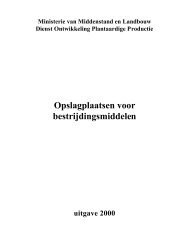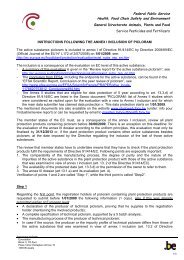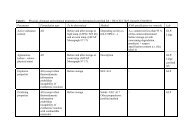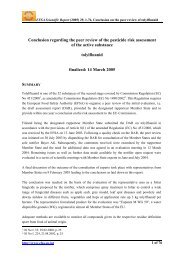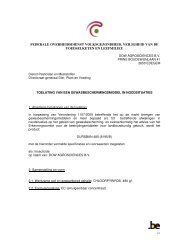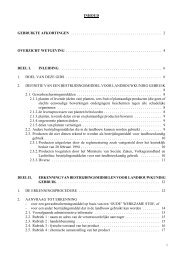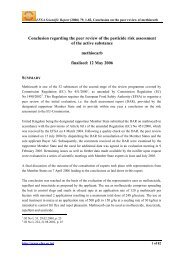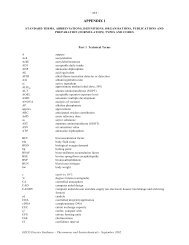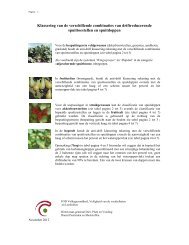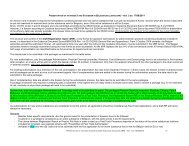Assessment of the Equivalence of Technical Materials - European ...
Assessment of the Equivalence of Technical Materials - European ...
Assessment of the Equivalence of Technical Materials - European ...
- No tags were found...
You also want an ePaper? Increase the reach of your titles
YUMPU automatically turns print PDFs into web optimized ePapers that Google loves.
a) Prediction <strong>of</strong> <strong>the</strong> expected increase in toxicity for assessing <strong>the</strong> ecotoxicologicalrepresentativenessA generic approach based on <strong>the</strong> pharmacological reference concept <strong>of</strong> concentrationadditivity (Loewe & Muischnek, 1926; Finney, 1971; Kortenkamp et al.., 2010) is suggestedas <strong>the</strong> preferred choice in cases where experimental ecotoxicity data on <strong>the</strong> new source orspecific impurities are lacking. This concept postulates a strictly similar mode-<strong>of</strong>-action (on<strong>the</strong> molecular scale) <strong>of</strong> <strong>the</strong> mixture component, whereas <strong>the</strong> individual potency (efficacy) canvary. For a multi-component system <strong>of</strong> n compounds, <strong>the</strong> concept allows a prediction <strong>of</strong>mixture effect concentrations based on single-compound effect concentrations according to<strong>the</strong> following equation.ECx( mix)() i()⎛ p= ⎜∑ n⎝ i ECxi⎞⎟⎠−1(1)with:n = number <strong>of</strong> mixture componentsi = index from 1…n, assigns <strong>the</strong> mixture componentsmix = mixtureEC x = concentration causing x % effectp(i) = relative fraction <strong>of</strong> <strong>the</strong> i-th component in <strong>the</strong> mixtureApplication for a binary mixture ABThe scenario refers to a binary mixture AB consisting <strong>of</strong> <strong>the</strong> impurity to be assessed, A at anamount <strong>of</strong> p(A) and <strong>the</strong> active substance, B (in this context: sum <strong>of</strong> all o<strong>the</strong>r mixturecomponents) at an amount <strong>of</strong> p(B) = 1 – p(A). If it is assumed that <strong>the</strong> toxicity <strong>of</strong> <strong>the</strong> impuritycompound A is higher by a factor <strong>of</strong> f than <strong>the</strong> active-substance compound B, <strong>the</strong> followingequation can be derived.ECx( AB)× ECx( A)( −1) × p( A) + 1= ff(2)If a value is known for <strong>the</strong> toxicity <strong>of</strong> <strong>the</strong> impurity compound A, this can be used forcalculating <strong>the</strong> factor f based on <strong>the</strong> also already known value for <strong>the</strong> overall toxicity <strong>of</strong> <strong>the</strong>mixture AB as follows.( B)( A)( AB) − p( A) × ECx( AB)( A) − p( A) × EC ( AB)ECxECxf = =(3)EC ECxxxCare must be taken that <strong>the</strong> effect concentrations <strong>of</strong> all individual compounds for an endpoint<strong>of</strong> interest are obtained under identical or at least largely similar test conditions (species, testduration, type <strong>of</strong> exposure, etc.), in order to allow <strong>the</strong> equation to be used. If suchexperimental values for effect concentrations do not exist, it is possible as an alternativeoption to estimate <strong>the</strong> order <strong>of</strong> magnitude <strong>of</strong> unknown effect concentrations using a validatedQSAR model. The applicability <strong>of</strong> a certain model for <strong>the</strong> concrete case must always besubstantiated.11



